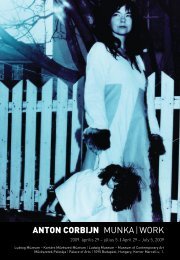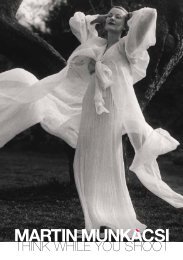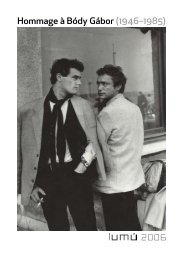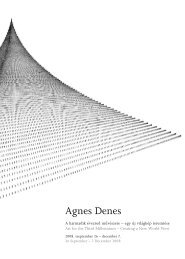Breuer Marcell kiállÃtás 2007 - Ludwig Múzeum
Breuer Marcell kiállÃtás 2007 - Ludwig Múzeum
Breuer Marcell kiállÃtás 2007 - Ludwig Múzeum
Create successful ePaper yourself
Turn your PDF publications into a flip-book with our unique Google optimized e-Paper software.
<strong>Breuer</strong> <strong>Marcell</strong> élete<br />
és alkotásai<br />
Kronológia<br />
The Life and Oeuvre<br />
of Marcel <strong>Breuer</strong><br />
Chronology<br />
<strong>Breuer</strong> <strong>Marcell</strong> Lajos 1902-ben született<br />
Pécsett. Érettségi után a bécsi Képzőművészeti<br />
Akadémiára nyert felvételt, de az<br />
Akadémia merev rendszere nem volt megfelelő<br />
számára. Ebben az időben ismerkedett<br />
meg egy másik pécsi művésszel, Forbáth<br />
Alfréddel, aki kapcsolatban volt Walter<br />
Gropiusszal, a Bauhaus vezető professzorával.<br />
Forbáth beszámolójából ismerte meg a<br />
Bauhaus úttörő pedagógia módszereit, és<br />
más pécsi művészekkel ‒ Molnár Farkassal,<br />
Johan Hugóval, Weininger Andorral ‒ együtt<br />
hallgatója lett a 20. század művészetét döntően<br />
befolyásoló iskolának. Itt felhagyott<br />
a képzőművészeti tevékenységgel és ‒ a<br />
Bauhaus gyakorlatias szellemének megfelelően<br />
‒ az asztalosműhelyben bútortervezést<br />
és -gyártást tanult.<br />
1924-ben fejezte be tanulmányait, majd<br />
Párizsban telepedett le. Személyes kapcsolatba<br />
került Le Corbusier-val és az avantgárd<br />
más kiemelkedő alkotóival, többek közt<br />
George Braque-kal, Fernand Léger-vel és<br />
Robert Delaunay-val. 1926-ban a Bauhaus<br />
Dessauba költözött, ekkor Gropius meghívta<br />
<strong>Breuer</strong>t, már mint tanárt, az asztalosműhely<br />
vezetésére. Ehhez a korszakhoz fűződik az<br />
első csőbútorok megalkotása. Az újításhoz<br />
az ötletet a bicikli inspirálta: ez könnyen<br />
hajlítható acélcsőből készül, mégis jól bírja<br />
a terhelést, ezért ülőbútor vázaként is felhasználható.<br />
A furcsa bútor eleinte nem<br />
váltott ki nagy elismerést. Azonban amikor<br />
Vaszilij Kandinszkij, a híres absztrakt<br />
festő elkezdte vásárolni <strong>Breuer</strong> bútorait,<br />
hamar divatossá váltak az avantgárd értelmiségi<br />
körökben. A racionális formaalkotás,<br />
az olcsón előállítható áramvonalas<br />
<strong>Marcell</strong> Lajos <strong>Breuer</strong> was born in 1902 in Pécs,<br />
southern Hungary. Following his graduation<br />
from high school, he was accepted to the Viennese<br />
Academy of Fine Arts, but the Academy’s<br />
rigid structure was not appropriate for him.<br />
During this time, he made the acquaintance<br />
of another artist from Pécs, Alfréd Forbáth,<br />
who was in contact with Walter Gropius,<br />
head professor at the Bauhaus. It was<br />
from Forbáth’s account that he learned of<br />
the pioneering pedagogical methods of the<br />
Bauhaus, and together with other artists<br />
from Pécs ‒ Farkas Molnár, Hugó Johan,<br />
Andor Weininger ‒ became a student of the<br />
Bauhaus, the decisively influential school of<br />
the twentieth century. Here he would also<br />
abandon his fine art activity, and ‒ in accordance<br />
with the functional spirit of the Bauhaus<br />
‒ he studied furniture design and manufacture<br />
in the carpentry workshop.<br />
He completed his studies in 1924, subsequently<br />
settling in Paris. He developed personal relations<br />
with Le Corbusier and other prominent<br />
figures of the avant-garde, such as Georges<br />
Braque, Fernand Léger and Robert Delaunay.<br />
In 1926 the Bauhaus moved to Dessau, at<br />
which time Gropius invited <strong>Breuer</strong> to come,<br />
this time as a teacher, to head the carpentry<br />
workshop. It is to this period that the creation<br />
of his first tubular furniture is linked. The<br />
idea for this innovation was inspired by the<br />
bicycle: it was produced from highly malleable<br />
steel tubing, which nevertheless could endure<br />
the load, and thus it was highly employable<br />
as framing for seating furniture. Initially, he<br />
did not gain much recognition for the strange<br />
furniture. However, when Wassily Kandinsky,<br />
the celebrated abstract painter, began to







